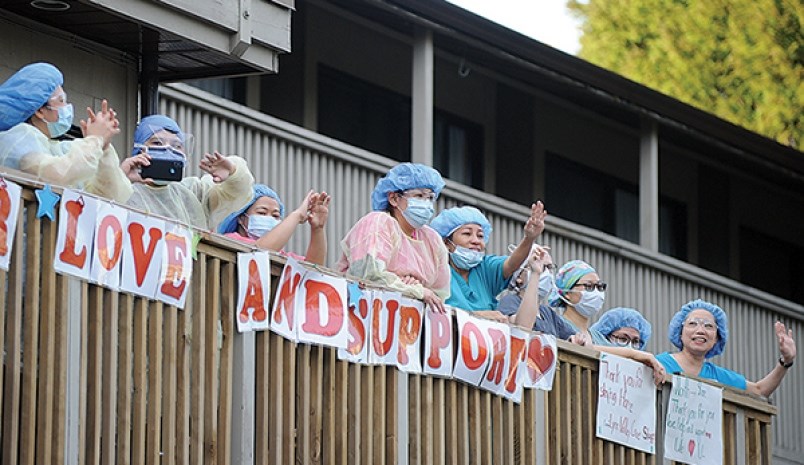Implementing B.C. anti-COVID-19 guidelines, crisis leadership competency and safety prioritization has been key to B.C. long-term care facilities (LTC) keeping residents infection-free, a has found.
“They really care about ensuring the well-being of their patients and their staff,” lead researcher School of Nursing Prof. Farinaz Havaei said. “Their decisions were not financially driven. Their decisions were driven by ensuring safety.”
But, while Vancouver’s Louis Brier Home and Hospital has kept its patients safe, it did find itself with a COVID outbreak as a result of staff becoming infected outside the facility, a situation facility CEO David Keselman said was quickly contained.
“None of our residents ever tested positive for COVID; the infection was contained to staff only,” he said. “It’s a lot to do with the team that’s here.
“Some of it is luck. Some of it is divine intervention and some it is what we’re doing here.
That wasn’t the case with many B.C. LTCs, though. As of Dec. 16, there were ongoing outbreaks at 56 B.C. facilities. The bulk of B.C. COVID deaths have been in care homes.
Indeed, the study said, the long-term care sector has been Canada’s COVID-19 epicentre, accounting for 81% of the country’s COVID-19-related deaths.
“The key drivers of high COVID-19 infection rates in LTC facilities are communal space use, low staffing ratios and ‘high-density’ physical contact between staff and residents due to residents’ high care needs,” said the study.
Research found facility staff were monitoring the COVID situation as early as December 2019 and had a dedicated infection control officer and risk and quality officer. By March, they instituted multiple control protocols. Havaei said management members having dealt with both SARS and influenza outbreaks gave them the experience to begin managing COVID early.
“The facility implemented most provincial guidelines to prevent or mitigate virus spread,” the study found. “Crisis leadership competencies and safety prioritization helped this site’s successful management of the pandemic.
“There was room for improvement in communication and staffing practices and policies in the facility.”
An issue arising early in the pandemic was that health workers were sometimes working in multiple facilities. The Ministry of Health soon ordered people to work at single sites only, a decree that created income issues for many workers.
The study said facilities needed to ensure compensation for those affected.
“This policy was particularly complex because decisions made between the [ministry], the health employers’ association and the unions were not clearly communicated to LTC facilities,” the study found. “A key challenge was an incomplete or inaccurate list of staff who worked multiple sites and their site of choice during the COVID-19 pandemic.”
Indeed, Havaei said, staffing is a key issue in an industry where understaffing was a problem before the pandemic.
She said homes have a registered nurse-to-patient ratio of about one to 40, significantly higher than in acute care, where the ratio is one-to-four.
Keselman said the 215-bed Louis Brier maintains 10% registered nurses (RNs), 20 licensed practical nurses and 70% support care aides. He said the professionally trained staff is needed to support the care aides.
He said RNs are used as clinical nursing leaders with one always available, an increase he pushed for.
“It wasn’t about having RNs at the bedside,” he said. “It was about having more RNs to support staff.”
The staffing issue generally, she said, needs to be studied in Canada.
COVID just added to workloads, she said.
“We need to be doing more in terms of long-term care staffing,” Havaei said.
That lack of communication from the provincial government also manifested itself around personal protective equipment, which, despite announcements from the provincial government, has long been the subject of complaints from those on the front lines.
“It felt chaotic,” Keselman said. “Everybody was dealing with chaos.”
“We stayed above water because we created our own pandemic management plan, but some of the communication from above did not give us much lead time to prepare for orders coming out,” one facility manager told researchers.
And sometimes there were conflicting communications. One was ‘All LTC employees must wear masks.’ But we didn’t have enough for all staff. Then an announcement was made that visitors could come back to LTCs, but we heard it at the same time as the public. We need lead time to prepare.”
Staff also found themselves filling in for family members unable to visit.
“We became the eyes, ears of loved ones,” one staffer told researchers. In order to further help families, staff also found ways to increase communication with families and between family members.
Havaei said that staff interaction helped seniors cope with isolation.
Glacier Media examined the LTC situation in a special series in July. Reporters found concerns about the , and as the second wave now being experienced were anticipated.
Keselman said he’s worked through AIDS, SARS and other crises and hopes lessons will be learned and implemented.
“I’m a little sceptical,” he said.


